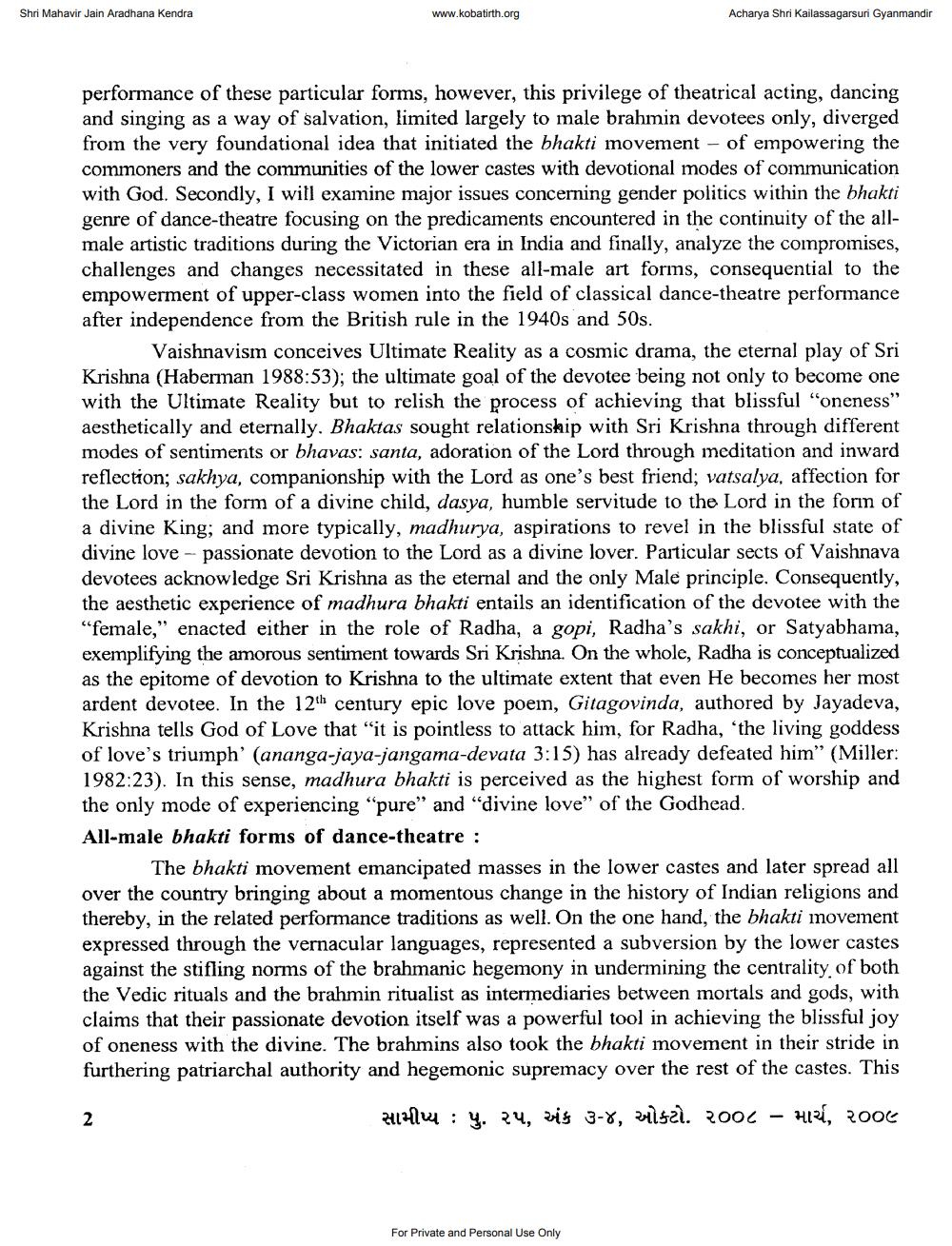Book Title: Samipya 2008 Vol 25 Ank 03 04 Author(s): R T Savalia Publisher: Bholabhai Jeshingbhai Adhyayan Sanshodhan Vidyabhavan View full book textPage 5
________________ Shri Mahavir Jain Aradhana Kendra www.kobatirth.org Acharya Shri Kailassagarsuri Gyanmandir performance of these particular forms, however, this privilege of theatrical acting, dancing and singing as a way of salvation, limited largely to male brahmin devotees only, diverged from the very foundational idea that initiated the bhakti movement - of empowering the commoners and the communities of the lower castes with devotional modes of communication with God. Secondly, I will examine major issues concerning gender politics within the bhakti genre of dance-theatre focusing on the predicaments encountered in the continuity of the allmale artistic traditions during the Victorian era in India and finally, analyze the compromises, challenges and changes necessitated in these all-male art forms, consequential to the empowerment of upper-class women into the field of classical dance-theatre performance after independence from the British rule in the 1940s and 50s. Vaishnavism conceives Ultimate Reality as a cosmic drama, the eternal play of Sri Krishna (Haberman 1988:53); the ultimate goal of the devotee being not only to become one with the Ultimate Reality but to relish the process of achieving that blissful "oneness" aesthetically and eternally. Bhaktas sought relationship with Sri Krishna through different modes of sentiments or bhavas: santa, adoration of the Lord through meditation and inward reflection; sakhya, companionship with the Lord as one's best friend; vatsalya, affection for the Lord in the form of a divine child, dasya, humble servitude to the Lord in the forin of a divine King; and more typically, madhurya, aspirations to revel in the blissful state of divine love - passionate devotion to the Lord as a divine lover. Particular sects of Vaishnava devotees acknowledge Sri Krishna as the eternal and the only Male principle. Consequently, the aesthetic experience of madhura bhakti entails an identification of the devotee with the "female," enacted either in the role of Radha, a gopi, Radha's sakhi, or Satyabhama, exemplifying the amorous sentiment towards Sri Krishna. On the whole, Radha is conceptualized as the epitome of devotion to Krishna to the ultimate extent that even He becomes her most ardent devotee. In the 12th century epic love poem, Gitagovinda, authored by Jayadeva, Krishna tells God of Love that "it is pointless to attack him, for Radha, 'the living goddess of love's triumph' (ananga-jaya-jangama-devata 3:15) has already defeated him" (Miller: 1982:23). In this sense, madhura bhakti is perceived as the highest form of worship and the only mode of experiencing "pure" and "divine love" of the Godhead. All-male bhakti forms of dance-theatre : The bhakti movement emancipated masses in the lower castes and later spread all over the country bringing about a momentous change in the history of Indian religions and thereby, in the related performance traditions as well. On the one hand, the bhakti movement expressed through the vernacular languages, represented a subversion by the lower castes against the stifling norms of the brahmanic hegemony in undermining the centrality of both the Vedic rituals and the brahmin ritualist as intermediaries between mortals and gods, with claims that their passionate devotion itself was a powerful tool in achieving the blissful joy of oneness with the divine. The brahmins also took the bhakti movement in their stride in furthering patriarchal authority and hegemonic supremacy over the rest of the castes. This 2011 : y. 24, Bis 3-8, msal. 2006 – Hizi, 2006 For Private and Personal Use OnlyPage Navigation
1 ... 3 4 5 6 7 8 9 10 11 12 13 14 15 16 17 18 19 20 21 22 23 24 25 26 27 28 29 30 31 32 33 34 35 36 37 38 39 40 41 42 43 44 45 46 47 48 49 50 51 52 ... 164
